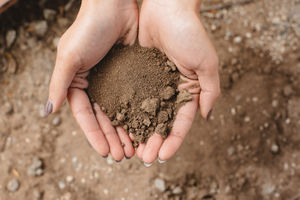Silt: Difference between revisions
| Line 3: | Line 3: | ||
[[File:Silty.jpg|thumb|right|Silt [6]]] | [[File:Silty.jpg|thumb|right|Silt [6]]] | ||
Silt is a | Silt is a granular sediment that can be transported and deposited by water, ice, and wind. Silt particles are larger than clay, but smaller than sand. To be classified as silt, a particle must be between .05 to .002 mm [1]. Similarly to [[clay]], sand, and gravel, silt is found in [[soil]]. Silt can also occur as sediment mixed in suspension with water. Because of silt’s spherical shape, it retains a large amount of water. Silty soil is known to be more fertile than other soils, and many species of [[organisms]] thrive in it. | ||
==Classification== | ==Classification== | ||
Revision as of 23:02, 8 May 2018
Definition

Silt is a granular sediment that can be transported and deposited by water, ice, and wind. Silt particles are larger than clay, but smaller than sand. To be classified as silt, a particle must be between .05 to .002 mm [1]. Similarly to clay, sand, and gravel, silt is found in soil. Silt can also occur as sediment mixed in suspension with water. Because of silt’s spherical shape, it retains a large amount of water. Silty soil is known to be more fertile than other soils, and many species of organisms thrive in it.
Classification
Formation
See also
- Clay
- Loam
- Founders of Soil Concepts
- Humus
- Microorganisms
- Pedogenesis
- Soil
- Soil Textures
- Soil Properties
- Jenny Equation
References
[1] Walter, David Evans, Gerald Krantz, and Evert Lindquist. 1996. Acari. The Mites. Version 13 December 1996. http://tolweb.org/Acari/2554/1996.12.13 inThe Tree of Life Web Project, http://tolweb.org/
[2] Pepato, Almir R, et al. “Phylogenetic Position of the Acariform Mites: Sensitivity to Homology Assessment under Total Evidence.” BMC Evolutionary Biology, BioMed Central, 2 Aug. 2010, bmcevolbiol.biomedcentral.com/articles/10.1186/1471-2148-10-235.
[3] Sanggaard, Kristian W.; Bechsgaard, Jesper S.; Fang, Xiaodong (6 May 2014). "Spider genomes provide insight into composition and evolution of venom and silk". Nature Communications. 5: 3765. Bibcode:2014NatCo...5E3765S. doi:10.1038/ncomms4765. PMC 4273655 Freely accessible. PMID 24801114.
[4] Dhooria M.S. (2016) Morphology and Anatomy of Acari. In: Fundamentals of Applied Acarology. Springer, Singapore
[5] “Acari.” Acari - Entomologists' Glossary - Amateur Entomologists' Society (AES), www.amentsoc.org/insects/glossary/terms/acari.
[6] Wilson, Nixon A. “Acarid.” Encyclopædia Britannica, Encyclopædia Britannica, Inc., 27 Dec. 2017, www.britannica.com/animal/acarid.
[7] NCSU Veterinary Parasitology, parasitology.cvm.ncsu.edu/vmp930/keys/mites/miteterms.html.
[8] Gulvik, M. "Mites (Acari) as indicators of soil biodiversity and land use monitoring: a review." Polish Journal of Ecology 55.3 (2007): 415.